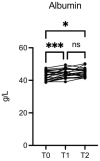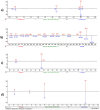Effect of a Phytochemical-Rich Olive-Derived Extract on Anthropometric, Hematological, and Metabolic Parameters
- PMID: 39339668
- PMCID: PMC11435251
- DOI: 10.3390/nu16183068
Effect of a Phytochemical-Rich Olive-Derived Extract on Anthropometric, Hematological, and Metabolic Parameters
Abstract
Background: Extra virgin olive oil is a fundamental component of the Mediterranean diet. It contains several molecules that sustain human well-being by modulating cellular metabolism and exerting antioxidant, anti-inflammatory, and anti-ageing effects to protect normal tissues, and it can exert anti-angiogenic and pro-apoptotic effects on cancer cells. Metabolites found in different parts of the olive tree, including leaves, also possess properties that might help in cancer prevention and promote wellness in aging. Olive mill wastewater (OMWW), a liquid residue produced during olive oil extraction, represents an environmental issue. However, it is rich in phytochemicals with potential beneficial properties. Dietary supplements based on OMWW can be produced for nutritional supplementation with advantages to the ecology.
Purpose: This work aims to measure hematochemical, anthropometric, and metabolomic parameters in volunteers taking an OMWW dietary supplement, Oliphenolia® (OMWW-OL).
Methods: The supplementation of OMWW-OL 25 mL twice daily for 30 days was tested on a pilot cohort of volunteers with characteristics close to metabolic syndrome. Hematochemical, anthropometric, serum biomarkers and serum metabolomic parameters were analyzed before the intervention, at 30 days, and 30 days after stopping consumption.
Results: A total of 29 volunteers were enrolled, and 23 completed the study. The participants' parameters at baseline were measured, and then twice daily at 30 days of treatment and 30 days after assumption discontinuation. Although treatment was with an olive derivative, their weight did not increase. Their body mass index, instead of augmenting, slightly decreased, particularly in the women. Also, hydration increased, especially in the women, while blood pressure, glycemia, and insulin decreased. Cholesterol, high-density lipoproteins, and triglycerides were stable, and LDL levels decreased, while vitamin D levels, alongside calcium, perceptibly increased. Albumin also increased. All the values were in support of an equilibrium, with no damaging effects. By mass spectrometry analysis, we also found favorable changes in the vitamin D/histamine and homocysteine/methionine ratios, an increase in a new metabolite of unknown formula, and the vitamin D/unknown metabolite ratio.
Conclusions: Supplementation of OMWW-OL has no detrimental effects and might imply the beneficial modulation of several biological parameters. Although this is a small pilot study, with limited potency, it preliminarily suggests that the OMWW extract use could be potentially valuable for people at risk of metabolic syndrome. Some of these parameters could also be relevant in supporting healthy ageing and in cancer prevention.
Keywords: antiaging; antioxidants; cancer; extra virgin olive oil; metabolic syndrome; olive mill wastewater; phytochemicals; polyphenols.
Conflict of interest statement
The authors declare that the research was conducted in the absence of any commercial or financial relationships that could be construed as potential conflicts of interest.
Figures











References
-
- Rossi M., Caruso F., Kwok L., Lee G., Caruso A., Gionfra F., Candelotti E., Belli S.L., Molasky N., Raley-Susman K.M., et al. Protection by Extra Virgin Olive Oil against Oxidative Stress In Vitro and In Vivo. Chemical and Biological Studies on the Health Benefits Due to a Major Component of the Mediterranean Diet. PLoS ONE. 2017;12:e0189341. doi: 10.1371/journal.pone.0189341. - DOI - PMC - PubMed
MeSH terms
Substances
Grants and funding
LinkOut - more resources
Full Text Sources
Medical

